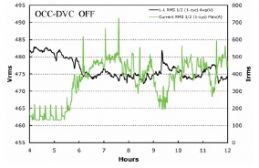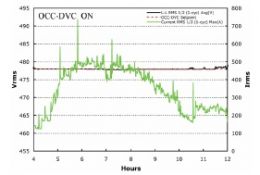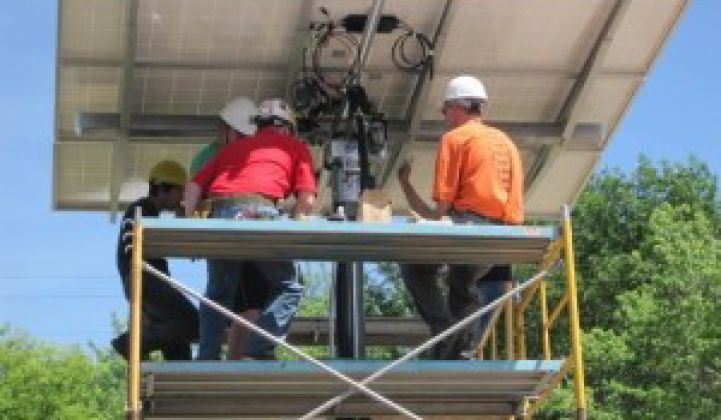After years of warning that the proliferation of solar panels could disrupt the grid without “smart inverters” to smooth out their intermittent power flow, a consortium of Western utilities led by San Diego Gas & Electric is demanding that regulators and the solar inverter industry do something about it.
That’s the gist of a statement (PDF), released Wednesday by the Western Electric Industry Leaders (WEIL) industry group, asking state utility regulators and lawmakers to start working with industry standards groups to set rules that would require all future solar installations to come with inverters capable of a specific set of grid-balancing tasks.
Smart inverters, the group says, could be a “low-cost way to mitigate the voltage changes caused by the fluctuating solar generation, thus preventing potential power quality problems.” They will certainly come with some cost -- WEIL’s white paper on the subject (PDF) estimates the requirement could add about 10 percent to manufacturing costs to inverters, which make up roughly 5 percent to 10 percent of total solar system installation costs.
But without them, the group warns, neighborhoods or regions where solar power makes up a significant portion of grid power -- including large swaths of California, Arizona and other western states with mandates calling for big increases in renewable power over the next decade -- could face increasing grid disruptions, costs for maintaining and strengthening the grid, and even more local power outages, all of which could eventually hobble solar power’s growth.
As a warning, the group points to Germany, the world leader in solar installations, where similar smart inverter regulations have been applied to address similar problems. A 2011 study by German utilities and energy agencies estimated that retrofitting the country’s installed solar base will cost €175 million ($234 million), and adding administrative costs could ring that cost up to $300 million. That’s a price tag that WEIL argues could be avoided in the United States, if regulators and the industry can get ahead of it.
“If we wait, and don’t get these standards put in place, and have to retrofit in the future, that would be a very expensive process,” Mike Niggli, president and COO of SDG&E, said in a Thursday interview. Compared to that, “adding a smart inverter at $150 per installation for each rooftop,” for an inverter system with a typical cost of about $1,500 or more, “is the no-regret solution, the long-term solution that gets to the heart of the problem.”
Defining the Smart Inverter, Function by Function
Consider Wednesday’s announcement the opening shot in what’s sure to be a years-long process of getting regulators and the solar industry on board with a major change to the way solar PV systems -- particularly small-scale residential and solar rooftop solar systems -- are configured and operated. While most of today’s inverters are technically able to perform the functions called for in WEIL’s manifesto, there remain many challenges to deal with before they can be “turned on” for real-world use.
Perhaps the simplest and easiest step toward a smarter inverter is in randomizing when they “trip,” or disconnect, from the grid. In the United States, the IEEE 1547 standards that govern distributed generation resources require them to disconnect at the first sign of trouble -- typically, when frequencies fall outside normal operating boundaries -- so they don’t feed dangerous and unexpected power back up downed or de-energized power lines.
But that simple safety feature can actually backfire on the grid, by suddenly disconnecting whole neighborhoods of solar power during momentary grid power blips or faults, causing even more instability. In Germany, that problem was dealt with by randomizing the timing and specific frequency levels at which they tripped, as well as when they reconnected, to shift what would have been a concentrated impact to a more spread-out one.
Similar functions include expanding the range of frequencies at which inverters trip offline, as well as allowing “low voltage ride-through,” which prevents them from tripping during voltage drops caused by momentary grid disruptions. While current IEEE 1547 rules don’t allow this, the latest revision to the standard, known as IEEE 1547.8, include some broader allowances for these kinds of changes.
“Some installations currently already have some of the functionality installed, but disabled,” Niggli noted. “In a number of areas, it would be fairly easy to switch on a limited amount of functionality that could help us immediately.”
Changing Regulations, Standards: The Next Steps
More complex are the inverter functions that actually alter the way it puts power onto the grid. These include real and reactive power support and dynamic VAR injection capabilities, which can actively manage some of the more troublesome voltage surges and sags inherent in the up-and-down power output coming from intermittent resources like solar and wind.
“In circuits that have a decent amount of penetration -- about 10 percent to 15 percent -- you can start to see significant waveform changes, as you’ve got clouds coming over, systems switching in and out,” Niggli said. Without smart inverter functions like VAR injection and power support, these fluctuations are much harder to manage, and the grid equipment that can do the task will wear out much more quickly, making it a much more expensive prospect.
Here are two charts from an SDG&E circuit that show how smart inverter functions can help, by bringing widely fluctuating voltage levels back to a steady, predictable flat line:


Allowing every inverter to perform these functions will take lots of work on the regulatory front, with changes to IEEE 1547 rules, as well as new testing and certification standards for getting them on the market. “We’re continuing to work with IEEE and Underwriters Laboratories, to make sure that everything comes together at once,” Niggli said.
MJ Shiao, GTM Research solar analyst, noted that most of the solar inverter manufacturers out there today are prepared to make these kinds of changes. In fact, many already enable them for projects in Germany and elsewhere.
“The technology exists, the functionality exists,” he said. “It’s more about figuring out what’s appropriate for the U.S. The manufacturers are saying, "We can do this; just tell us where and when.” Shiao added that the firmware upgrades to enable these latent functions should be a fairly simple and inexpensive task.
“Where the costs really come in are in overhead for testing,” he said. “If SDG&E implements this, you now have to get new UL certification,” and if every utility or state implements different rules, that extra cost could become onerous. That’s why the Western utilities that make up WEIL have decided to come together to seek a single set of standards, Niggli said.
“We want to get both the IEEE and UL certifications on a spec standing, and have all the manufacturers go through it at one time,” he said. “Once they have that certification, they can roll that out en masse to all the solar installers.”
Taking the Long View to Solving the Solar Challenge
Most of these functions can be done automatically by individual inverters, by the way. At the same time, utilities are eager to have some form of communications established with inverters, to be able to monitor how they’re automatically adjusting to these fluctuations, and in certain cases, to actively control them as grid assets. In the United States, the Electric Power Research Institute (EPRI) and industry members have been working on inverter communications standards for years now, and WEIL’s report says that it’s relying on these kinds of standards to come into being.
Niggli noted that large utility-scale and community-scale solar systems aren’t as big of a problem as the smaller rooftop systems being added at record-setting pace -- in SDG&E territory, about 800 a month at present rates.
How will the solar industry react to these calls for action? Niggli said that WEIL members have been in contact with inverter manufacturers to formulate the specific set of functions they’re calling for, but haven’t yet seen a reaction from the broader industry.
“But I am certain of two things,” he said. “One, they want to make sure that costs are not impacted for their installations, so they can stay competitive. But secondly, I’m sure they want to make sure that quality installations go in that don't cause problems with their future business model.”
It’s a bit hard to quantify the costs and benefits of making all new solar inverters smarter, versus taking other approaches based on adding new grid equipment, because for the most part, the problem of too much solar is a hypothetical one. But as panel prices continue to drop, and solar installations continue to accelerate, it could quickly become an issue requiring regulatory action like what Germany has done -- or, Niggli said, it could force utilities to delay or prevent the installation of more solar to avoid grid reliability safety problems.
“Honestly, I think this is the easiest way to solve the problem,” Shiao said. “I don’t know that it’s necessarily a problem now -- that may be jumping the gun -- but the discussion needs to happen now.”



